The Incredible Shrunken Kids
Researchers are using nanotechnology to develop superfast computers, amazing materials, and tiny robots.
Share this:
- Share via email (Opens in new window) Email
- Click to share on Facebook (Opens in new window) Facebook
- Click to share on X (Opens in new window) X
- Click to share on Pinterest (Opens in new window) Pinterest
- Click to share on Reddit (Opens in new window) Reddit
- Share to Google Classroom (Opens in new window) Google Classroom
- Click to print (Opens in new window) Print
By Emily Sohn
The smallest kids on Earth are much smaller than you or your baby brother or sister. They’re smaller than a flea. They’re even smaller than the hairs on a flea’s leg. These tiny tykes are so small, in fact, that 20 billion billion of them can fit into a jar, with lots of room to spare.
They have names such as NanoJester, NanoScholar, NanoBaker, NanoPilgrim, and NanoTexan. “We made a whole community of them,” says chemist James Tour of Rice University in Houston, Texas. “We call them NanoPutians.”
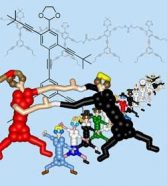 |
|
Members of the NanoPutian molecular community. Each cartoon figure is based on a molecule consisting of carbon, hydrogen, and oxygen atoms.
|
| © Rice University |
Also known as NanoKids, the NanoPutians aren’t real people. You can’t knock on miniature doors to ask miniature parents if the NanoKids can come out to play. NanoKids are actually tiny molecules made to look a little bit like people.
Tour invented the Nanoputians as a way to teach kids about nanoscience, the study of extremely small things. Nanoscience and nanotechnology have been getting more and more attention lately throughout the scientific world, from chemistry and biology to physics and engineering.
In Japan, Great Britain, Germany, the United States, and other countries, researchers are using nanotechnology to develop superfast computers, new medicines, amazing materials, teeny robots, and much, much more. They’re looking to nanotechnology to help solve some of the world’s most serious health, environmental, and energy problems.
Tiny things
The prefix “nano” means one-billionth. So, 1 nanosecond is one-billionth of a second, and 1 nanometer is one-billionth of a meter. A human hair is about 80,000 nanometers wide.
Nanoscience (or nanotechnology) refers to the study of things that are smaller than about 100 or 200 nanometers. The exact size is less important than the possible applications of working with such tiny things, Tour says. “Nanoscience is the study and development of the small so that it will affect the large,” he says.
One of the basic goals of nanotechnology research is to control individual atoms. Carbon, hydrogen, oxygen, and other types of atoms are the building blocks of the universe. They make up galaxies, stars, planets, rocks, water, people, trees, CDs, cells—all the stuff out there.
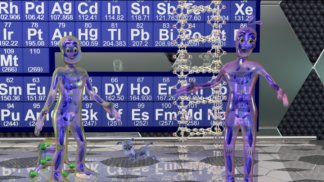 |
|
In an animated NanoKid adventure, two NanoPutians welcome a newcomer to the NanoLoft, a nanoscale hangout in a computer’s jungle of circuits and transistors. The background shows part of the periodic table of elements, the building blocks of matter.
|
| © Rice University |
Most things that people build come together in a “top-down” way, Tour says. If you want to make a table, for instance, you cut down a big tree, make wooden boards, and hammer them together.
Nature, on the other hand, builds things from the bottom up. When atoms join together, they make molecules. Each molecule has a certain shape, and a molecule’s structure determines what it can do. Molecules can then come together to make a cell—or a tree.
Copying nature
Nanotechnologists want to do what nature does. They want to create tiny, intricate structures—atom by atom or molecule by molecule—that have specific features or applications.
For example, instead of cutting and processing thin slices of silicon to make computer chips, engineers work with individual molecules to build computer processors and memories. Putting such molecules together would create a tiny chip that could hold an enormous amount of memory. You could end up with a supercomputer the size of your cell phone.
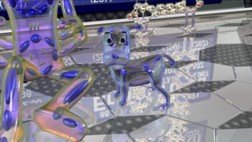 |
|
NanoDog is a single molecule. If you look closely, you can see the atoms (shown in violet) that make up his “skeleton.”
|
| © Rice University |
Eventually, nanotech could touch every part of our lives. There might be molecular motors and nanorobots that can build other nanomachines. In medicine, nanodevices could go inside the body to deliver drugs exactly where they need to go, monitor vital signs, or perform delicate operations. A nanoscale coating on glass could help turn the sun’s energy into electricity. Nanotech could also help make light bulbs more efficient.
Already, a company called Nano-Tex makes fabrics with different kinds of “molecular hooks” that can repel stains, eliminate wrinkles, or shed water. In the future, nanotech-enhanced clothes could respond to the weather to warm you up or cool you down.
The U.S. Navy is using nanotech coatings on their submarines to keep sea creatures off and reduce corrosion. Other nanomaterials could lead to lightweight airplanes and other types of equipment.
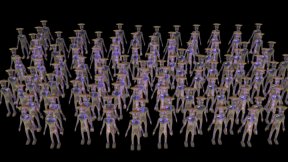 |
|
A collection of NanoScholar molecules.
|
| © Rice University |
The possibilities for nanotechnology may seem limitless, but there are potential problems that already worry some people.
Certain nanoscale particles could cause health problems, for example. Researchers have already found that molecules known as buckyballs can harm living cells (see “Little Bits of Trouble” at http://www.sciencenewsforkids.org/articles/20040407/Note2.asp ).
And what about nanobots that could make copies of themselves, growing in number so quickly that they take over the world, destroying the environment?
The more scientists learn, though, the less there is to fear, Tour says. After all, people are skeptical of every new technology at first, but they get used to it. They just have to use it in a responsible way.
Cutting edge
Even though nanotechnology is on the cutting edge of scientific research, studying such small things can be challenging and frustrating. It can also be fun and exciting.
A few years ago, Tour was helping his 15-year-old daughter with her chemistry homework. “It was just terrible,” he says. “She hated it because it wasn’t anything like the real world. ‘I can’t believe you do this for a living,’ she said to me. I said, ‘This isn’t what I do! It’s really fun. It’s exploration.'”
Soon after, the NanoKids were born. Tour and his colleagues made their nanocommunity out of single molecules, combining carbon, hydrogen, and oxygen to create each member.
NanoKid, for example, consists of 39 carbon atoms, 42 hydrogen atoms, and 2 oxygen atoms. It stands about 2 nanometers tall. NanoAthlete is made up of 42 carbon atoms, 48 hydrogen atoms, and 2 oxygen atoms. NanoAthlete stands a little taller than NanoKid.
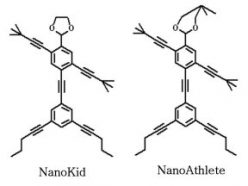 |
|
NanoKid consists of 39 carbon atoms, 42 hydrogen atoms, and 2 oxygen atoms. NanoAthlete is made up of 42 carbon atoms, 48 hydrogen atoms, and 2 oxygen atoms. These diagrams show the two molecular structures. Each line segment indicates a chemical link, or bond, between atoms. The two Os stand for oxygen atoms. Carbon atoms are located at each corner or intersection in the diagrams.
|
| © Rice University |
If NanoKid were to stand on the eye of a fly, its size would be comparable to that of a person standing on Earth’s surface. That’s tiny!
Tour and his coworkers turned these molecular structures into cartoon figures and made an animated science video about the little people, set it to music, and started showing it to kids in school while talking about how exciting research on small things can be.
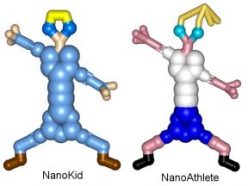 |
|
Cartoon versions of NanoKid and NanoAthlete.
|
| © Rice University |
Learning about the NanoKids has opened up a world of possibility for real kids who ordinarily would rather not study biology, chemistry, or physics, Tour says.
When you look closely enough, the really small can be really cool.
Going Deeper:







